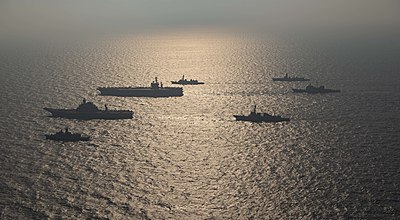
 An Indian Navy Explosive Ordnance Disposal technician and a U.S. Navy Sailor launch an autonomous underwater vehicle, Malabar 2016.
An Indian Navy Explosive Ordnance Disposal technician and a U.S. Navy Sailor launch an autonomous underwater vehicle, Malabar 2016. Urban combat training during Malabar 2021. MARCOS, US Navy SEALs and JMSDF special forces visible.
Urban combat training during Malabar 2021. MARCOS, US Navy SEALs and JMSDF special forces visible.
Exercise Malabar is a naval exercise involving the United States, Japan and India as permanent partners. Australia re-joined the exercise in 2020. The annual Malabar exercises includes diverse activities, ranging from fighter combat operations from aircraft carriers through maritime interdiction operations, anti-submarine warfare, diving salvage operations, amphibious operations, counter-piracy operations, cross–deck helicopter landings and anti–air warfare operations. Over the years, the exercise has been conducted in the Philippine Sea, off the coast of Japan, the Persian Gulf, in the Bay of Bengal and the Arabian Sea. It is conducted by the Asian and the North American Commands.
The exercise started in 1992 along the Malabar Coast as a bilateral exercise between India and the United States. It was expanded in 2007 with the participation of Japan, Singapore and Australia. Japan became a permanent partner in 2015. Since 2020, Australia participated in the exercise again, marking the second time that the Quad will be jointly participating in a military exercise. The aim of the exercise includes increasing interoperability between the naval forces.
The duration of the exercise has ranged from 1 to 11 sea-days. The complexity and sophistication of the exercise has increased over the years. Exercises have on-shore and at-sea stages. The average participation by India increased from 8 ships to just over 9 from 2002 to 2014.
Exercises have included aircraft carriers (USS Nimitz, Kitty Hawk, Ronald Reagan, George Washington, INS Vikramaditya, Viraat), helicopter carriers (JS Kaga, Izumo, Ise, Hyūga), frigates, submarines (diesel-electric and nuclear), destroyers, guided-missile vessels, cruisers, amphibious ships and auxiliary ships such as tankers. Coast guard vessels have also taken part. Aircraft have included the P3C Orion, Poseidon P8I, Tupolev Tu-142, Kawasaki P-1, ShinMaywa US-2, F/A 18 Super Hornets, Jaguars, Sea Harrier jets and Sea King helicopters. Special forces have also taken part.
1992–2002
The first Malabar exercise between India and the United States was held on 28/29 May 1992. The exercises were located along the Malabar Coast in Cochin, headquarters of the Indian Southern Naval Command, and Goa. It was of an elementary level, including four vessels, passing exercises and basic maneuvers. Two more exercises were conducted before 1998, when the Americans suspended exercises after India tested nuclear weapons.
| Edition | Year | Participants | Exercise Area | Vessels | Exercises | Ref |
|---|---|---|---|---|---|---|
| 1 | 1992 | India's west coast | Frequency sharing, basic maneuvers, search and rescue. | |||
| 2 | 1995 | Persian Gulf | ||||
| 3 | 1996 | India's west coast |
2002–2007



The United States renewed military contact following the 2001 September 11 attacks when India joined President George W Bush's campaign against international terrorism. The 2003 exercises featured sub-surface exercises for the first time. In 2005 India and US signed the New Framework for the India - U.S. Defence Relationship. Malabar 2005 saw the inclusion of aircraft carriers from both navies for the first time. 2006 was the first time expeditionary exercises took place with a United States Expeditionary Strike Group (ESG) leading the exercise. Malabar 2007 was the first time three aircraft carriers took part.
In 2007, the Quadrilateral Security Dialogue, an initiative between Japan, United States, Australia and India impacted the Malabar exercise. In 2007, for the first time, navies other than Indian and US joined the exercise with the armada including Japan, Singapore and Australia. Also for the first time, the exercise was shifted from the Indian Ocean to the Pacific Ocean.
India's Left Front parties that have criticised Prime Minister Manmohan Singh's government on the India-US civilian nuclear deal had vehemently protested the exercise, seeing it as another sign of the growing closeness between the two countries. At one time, the Indian government was known to have considered postponing or canceling the exercise but the Indian Navy put its foot down, saying the logistics involved made any delay impossible. Protests against USS Nimitz were seen in India when it dropped anchor off Chennai in July.
China, which did not officially comment on the exercise, was known to be unhappy over the event as it was being conducted in the Bay of Bengal for the first time. China has been cultivating naval cooperation with Bangladesh and Myanmar to gain access to the Bay of Bengal and has been strengthening military cooperation with Sri Lanka. In June, China had issued a 'demarche' to India, United States, Japan and Australia seeking details about their four-nation meeting, termed a Quadrilateral Initiative. India and Australia had quickly assured Beijing that security and defence issues did not form part of the meeting's agenda.
| Edition | Year | Participants | Exercise Area | Vessels | Exercises | Ref |
|---|---|---|---|---|---|---|
| 4 | 2002 | Arabian Sea | Basic passing maneuvers, anti-submarine (ASW) exercises and replenishment-at-sea drills | |||
| 5 | 2003 | India's west coast | 3 dimensional, anti-submarine warfare exercises, helicopter maneuvers, VBSS drills | |||
| 6 | 2004 | India's west coast | INS Aditya, INS Mysore, INS Brahmaputra, INS Shankul | War at sea, submarine familiarization exercises, small boat transfers, group maneuvers, nighttime maneuvers, VBSS drills | ||
| 7 | 2005 | India's west coast |
|
Dissimilar air combat tactics (DACT), joint salvage diving exercises, a 24-hour 'war at sea' simulation | ||
| 8 | 2006 | India's west coast | USS Boxer Expeditionary Strike Group (BOXESG; 13 ships including amphibious ships, cruisers, destroyers, USS Providence, marines from the 15th Marine Expeditionary Unit)
Indian guided missile frigates and destroyers Coast guard ships included USCGC John Midgett and an Indian Coast Guard patrol ship |
Expeditionary ops. Exchange of coast guard practices in maritime law enforcement, anti-piracy operations, pollution control, search and rescue, and VBSS support.
During the second phase, BOXESG conducted Indian port stops including Mumbai and Goa allowing it a chance to experience Indian culture, re-supply, and support a Habitat for Humanity project. |
||
| 9 | 2007 | Philippine Sea | Three carriers INS Viraat, USS Nimitz, USS Kitty Hawk
USS John S. McCain, USS Mustin, USS Curtis Wilbur, USS Fitzgerald, USS Stethem, USS Gary, USS Greeneville INS Mysore, INS Rana, INS Ranjit, INS Jyoti, INS Kuthar and various Indian Naval aircraft. |
Command of the sea, maritime interdiction, exercises in all warfare areas. VBSS drills, surface exercises, coordinated fire, air defense and ASW exercises. | ||
| 10 | 2007 | Bay of Bengal | 27 ships (8 of Indian Navy, 14 from US Navy, and the remaining from JMSDF, RAN, RSN)
USS Nimitz, USS Kitty Hawk, USS Chicago, two guided missile cruisers, and six guided missile destroyers. INS Viraat, INS Mysore, INS Rana, INS Ranjit, INS Jyoti, INS Kuthar RAN represented by a frigate and a tanker; JMSDF by two destroyers; and RSN by a frigate. |
DACT, cross deck exercises, patrollings, air defence and ASW exercises, exercises related to maritime threats |
2008–2014


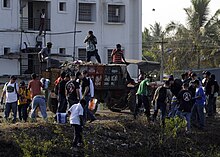
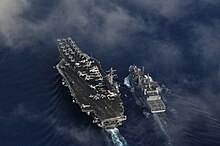
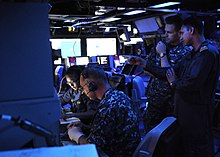

Domestic political changes in Australia and Japan, as well as China's opposition, resulted in Malabar 2008 being on a much smaller scale with only participation from India and the US, and being conducted in the Indian Ocean. Some protests in India against the 2008 exercise were led by the Communist Party of India (Marxist).
While the 2009 exercises were trilateral, India did not participate in the amphibious assault exercise in Japan.
India had stopped involving more countries in the exercises after China, in 2007, sent demarches to all the participants of a five-nation naval exercise held in the Bay of Bengal. With the Japanese participation in 2009 raising no political storm, India was once again agreeable to the idea of allowing the JMSDF to participate.
The Tōhoku earthquake and tsunami on the east coast of Japan in March 2011 caused Japan to back out of the next Malabar which was held off the Okinawa coast.
| Edition | Year | Participants | Exercise Area | Vessels | Exercises | Ref |
|---|---|---|---|---|---|---|
| 11 | 2008 | Arabian Sea | USS Ronald Reagan's Carrier Strike Group Seven, USS Springfield, USNS Bridge, USS Gridley, USS Thach, USS Decatur
INS Mumbai, INS Rana; INS Talwar, INS Godavari, INS Brahmaputra, INS Betwa, INS Aditya; and a submarine. |
Surface, sub-surface and air exercises, firing exercises, VBSS | ||
| 12 | 2009 | Japan | INS Mumbai, INS Khanjar, INS Ranvir, INS Jyoti, JDS Kurama, JDS Asayuki, USS Blue Ridge, USS Fitzgerald, USS Chafee, USS Seawolf | VBBS techniques, surface warfare maneuvers, anti-submarine warfare, gunnery training, air defense. | ||
| 13 | 2010 | India's west coast | USS Shiloh, USS Lassen, USS Chafee, USS Curts, USS AnnapolisINS Mysore, INS Godavari, INS Brahmaputra, INS Tabar, INS Shishumar | Surface and anti-submarine warfare, coordinated gunnery exercises, air defense, and visit, board, search, and seizure drills. Sailors took part in professional exchanges and discussions while at-sea and on shore. US Navy personnel participated in a community service project during the port visit to Goa. | ||
| 14 | 2011 | Japan | Carrier Strike Group Seven. Sterett, Stethem; Reuben James; USS Santa Fe | Exercise's coincided with the Indian Navy's western Pacific deployment. Exercise events included liaison officer professional exchanges and embarks; communications exercises; surface action group exercise operations; formation maneuvering; helicopter cross deck evolutions; underway replenishments; humanitarian assistance and disaster relief; gunnery exercises; VBSS; maritime strike; air defense; screen exercise and ASW. | ||
| 15 | 2012 | Bay of Bengal | Carrier Strike Group 1 comprising USS Carl Vinson, embarked Carrier Air Wing 17, USS Bunker Hill, USS Halsey, USNS Bridge.
INS Satpura, INS Ranvir, INS Ranvijay, INS Kulish, INS Shakti |
Communications exercises, surface action group (SAG) operations, helicopter cross-deck evolutions, and gunnery exercises. The participants split into two SAGs, with Bunker Hill leading one and Satpura leading the other. | ||
| 16 | 2013 | India's east coast | USS McCampbell | 'At-Sea' phase included professional exchanges and embarkations; communications exercises; Surface Action Group operations; leapfrogs; helicopter cross-deck evolutions; gunnery exercises; VBSS and ASW. | ||
| 17 | 2014 | Japan | INS Ranvijay, INS Shivalik, INS ShaktiUS Navy Carrier Strike group based on USS George Washington, one submarine, two destroyers, one tanker | Carrier strike group operations, maritime patrol and reconnaissance operations, anti piracy and VBSS exercises, search and rescue exercises, helicopter cross-deck landings, underway replenishment, gunnery and ASW exercises, and liaison officer exchange and embarkation. |
2015–2019



On 26 January 2015, the U.S. President and Indian Prime Minister agreed, in a joint statement, to upgrade exercise Malabar. India invited Japan to be a part of exercise, held in the Bay of Bengal. Japan joined as a permanent member.
In 2015, the United States brought up the fact that India was doing its "bare minimum" with regard the participation in the exercise. However, seeming to understand India's limitation, the United States has also responded accordingly. For India, one of the reasons for converting Malabar into a multilateral exercise has been "resource optimisation". As the number of maritime bilateral exercises over the years has been increasing, the Navy's resources are heavily strained. Further, the returns from the international exercises seem to be levelling out. Inviting China to "socialise" during the Malabar exercises has been suggested.
The 2018 Malabar exercise was conducted from 7 to 16 June 2018 off the coast of Guam in the Philippine Sea. This was the 22nd edition of the exercise and the first time it was held on United States territory. The exercise is divided into two phases. The harbour phase was held from 7 to 10 June at Naval Base Guam, and the sea phase from 11 to 16 June. Based on news reports, India refused Australia participation in the exercise to avoid posturing it as a military group against China.
| Edition | Year | Participants | Exercise Area | Vessels | Exercises | Ref |
|---|---|---|---|---|---|---|
| 18 | 2015 | Bay of Bengal | INS Sindhuraj, INS Ranvijay, INS Shivalik, INS Betwa, INS ShaktiUSS Theodore Roosevelt, USS Normandy, USS Fort Worth, USS City of Corpus Christi | |||
| 19 | 2016 | Philippine Sea | USS John C. Stennis with embarked Carrier Air Wing 9, USS Mobile Bay, USS John C. Stennis, USS Stockdale, USS William P. Lawrence, USS Chung-Hoon
INS Satpura, INS Sahyadri, INS Shakti
|
Submarine familiarization (SUBFAM); high-value unit exercises; medical drills and other exercises and maneuvers. | ||
| 20 | 2017 | Bay of Bengal | A total of 16 ships, 2 submarines and 95 aircraft participated in this exercise.INS Vikramaditya, INS Ranvir, INS Shivalik, INS Sahyadri, INS Kamorta, INS Kora, INS Kirpan, Sindhughosh-class submarine, INS Jyoti
USS Nimitz, USS Princeton, USS Howard, USS Shoup and USS Kidd, a Los Angeles-class submarine JS Izumo and its air wing, JS Sazanami |
Aircraft carrier operations, air defense, ASW, surface warfare, VBSS, search and rescue (SAR), joint and tactical procedures. Joint training between the naval special forces. | ||
| 21 | 2018 | Philippine Sea | INS Sahyadri, INS Kamorta, INS ShaktiUSS Ronald Reagan. USS Antietam
USS Chancellorsville, USS Benfold, USS Mustin, a Los Angeles-class submarine JS Ise, JS Sazanami, JS Fuyuzuki, a submarine |
Onshore and at-sea training, aircraft carrier operations, maritime patrol and reconnaissance operations, visit, board, search and seizure operations and professional exchanges | ||
| 22 | 2019 | Japan | INS Sahyadri, INS Kiltan |
2020–present


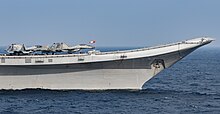
Malabar 2020 was a "non-contact, at sea only" exercise taking into consideration COVID-19 pandemic. It was decided that Australia shall also be a part of the Malabar Naval exercise, in view to support a free, open and rule based Indo Pacific. Since the revival of the Quad by the US in November 2017, India had been reluctant to incorporate Australia into the Malabar exercise since it would have reinforced the false perception that the Quad was a de-facto military alliance. However, following China's aggressive actions against India in the disputed land border area of Galwan Valley (Ladakh), India agreed to enhance its deterrence against China by welcoming Australia into the Malabar exercise. This is the first time that all four navies of the Quad will be in a joint exercise in 13 years. US Deputy Secretary of State Stephen E Biegun, on 20 October 2020, said that Quad should be "more regularised", and at some point "formalised" with the passage of time.
It was reported in the Sunday Telegraph on 7 March 2021 that France planned to join the four other nations in 2021, and had planned its annual Jeanne d'Arc naval exercise around this event. Since the revival of the Quad in November 2017, much against the pushing by the Americans, India had resisted the incorporation of a 'willing' Australia into Malabar exercises. This was essentially to avoid propagating a false perception that the Quad was a de-facto military alliance. However, after China's aggressive move against India in Galawan (Ladakh) in 2020, India relented and welcomed Australia into Malabar, making it a quadrilateral exercise.
See also
- Geostrategy
- AirSea Battle
- Interoperability
- Blue Team (U.S. politics)
- China containment policy
- India–United States relations
- List of disputed territories of China
- Quadrilateral Security Dialogue
- String of Pearls (Indian Ocean)
- Territorial disputes in the South China Sea
- US-Philippines Balikatan Exercise
- International relations
- India-China relations
- China-United States relations
- India-Australia relations
- India-Japan relations
- India–United States relations
Notes
- Named after the south-west Indian coast, Malabar Coast, where the first exercise was conducted.
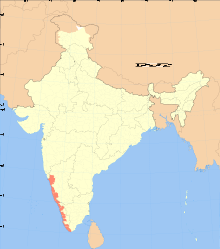
Map showing Malabar Coast - ^ Other vessels such as tankers and various naval aircraft, including those attacked to aircraft carriers, also take part
References
- Gady, Franz-Stefan (5 June 2018). "India, US, and Japan to Hold 'Malabar' Naval War Games This Week". The Diplomat. Archived from the original on 13 June 2018. Retrieved 5 June 2018.
- ^ "Military Exercises –– Feb to Nov 2008. Indo–US Bilateral Naval Exercise – Malabar 08". indiadefence.com (India Defence Consultants). 17 November 2008. Archived from the original on 19 December 2008. Retrieved 28 November 2008.
- ^ Khurana, Gurpreet S (5 August 2014). "India-US MALABAR Naval Exercises: Trends and Tribulations". National Maritime Foundation. Retrieved 5 November 2020.
- "Malabar 2020 Naval Exercise". Press Information Bureau, Government of India. Ministry of Defence. 19 October 2020. Retrieved 5 November 2020.
{{cite web}}: CS1 maint: others (link) - "Malabar Drill: India, US, Japan and Australia kick off Malabar drill; China reacts". The Times of India. 3 November 2020. Retrieved 5 November 2020.
- ^ Vinay Garg (2007). "Exercise Malabar-2007: A Major Step Towards Finetuning Maritime Capabilities". Sainik Samachar. Archived from the original on 15 May 2013. Retrieved 9 January 2013.
Exercise Malabar, named after the scenic south-west coast of India, is the generic name given to the Indo- US naval interaction.
- ^ Pant, Harsh V.; Mann, Anant Singh (14 August 2020). "India's Malabar Dilemma (ORF Issue Brief No. 393)". Observer Research Foundation. Retrieved 7 November 2020.
- ^ Joshi, Shashank (9 October 2015). "Malabar: Modi Government misses an opportunity as annual exercise slumps". Lowy Institute. The Interpreter. Retrieved 14 October 2021.
- ^ Smith, Jeff M. (2014). Cold peace: China-India rivalry in the twenty-first century. Lanham, Maryland : Lexington Books. pp. 182–186. ISBN 978-1-4985-2092-8 – via Internet Archive.
- ^ "Malabar 2008: India, United States Begin Arabian Sea Naval War Games from October 20th 2008". Indian Defence. 18 October 2008. Archived from the original on 7 March 2012. Retrieved 27 December 2011.
- ^ "Exercise Malabar commences in Bay of Bengal/ North Indian Ocean". www.indiannavy.nic.in. Archived from the original on 11 July 2017. Retrieved 12 July 2017.
- ^ "Indo - US Naval Exercise 'MALABAR 2013' Commences in Bay of Bengal". www.indiannavy.nic.in. Indian Navy Press Release. Archived from the original on 28 April 2019. Retrieved 28 April 2019.
{{cite web}}: CS1 maint: others (link) - ^ "Exercise Malabar 2019". Indian Navy. Archived from the original on 26 September 2019. Retrieved 26 September 2019.
- ^ "Malabar 2014: A Multilateral Naval exercise starts". Indian Navy Press Release. Archived from the original on 14 July 2015. Retrieved 26 July 2014.
- ^ Ved, Mahendra (September 2007). "Indian Navy's Malabar and other Exercises". India Strategic. Archived from the original on 17 January 2013. Retrieved 9 January 2013.
- ^ Charles Oki (23 April 2010). "U.S. Navy prepares to participate in Exercise Malabar 2010". U.S. 7th Fleet. Archived from the original on 20 February 2013. Retrieved 5 June 2014.
- Rajagopalan, Rajeswari Pillai (15 November 2019). "Tiger Triumph: US-India Military Relations Get More Complex". The Diplomat. Archived from the original on 1 March 2020. Retrieved 1 March 2020.
- ^ Khattak, Mahrukh (1992). "Indo–US Naval Exercises". Strategic Studies. 15 (1): 7–10. ISSN 1029-0990. JSTOR 45182074.
- "India, US hold naval exercises". BBC News. 5 October 2003. Archived from the original on 4 March 2016. Retrieved 2 December 2008.
- Nadkarni, Vidya (21 January 2010). Strategic Partnerships in Asia: Balancing Without Alliances. Routledge. p. 158. ISBN 978-1-135-26525-0.
- ^ Cherian, John (21 September 2007). "The battle is on". Frontline. The Hindu. Retrieved 15 October 2021.
- ^ Sathe, Abhijeet (29 September 2005). "Indo-US navy exercises:More than expected achieved". Rediff. Archived from the original on 6 March 2016. Retrieved 28 April 2019.
- "USS Nimitz touches Chennai port despite protests". International Reporter. MIL/NDTV. 2 July 2007. Archived from the original on 28 August 2008.
{{cite web}}: CS1 maint: others (link) - "What is Malabar naval exercise? Why is Chinese media considering it a threat?". India Today. 10 July 2017. Archived from the original on 26 February 2020. Retrieved 26 February 2020.
- Ramananda Sengupta; Nikhil Lakshman (2006). "Your navy is world class: Interview: US Pacific Fleet Commander Gary Roughead". Rediff. Archived from the original on 13 May 2013. Retrieved 3 May 2012.
- ^ Annual Report. 2002-2003. Ministry of Defence. Government of India. pg 27. Retrieved on 13 October 2021.
- Griffin, Christopher J. (31 December 2006). "What India Wants". American Enterprise Institute. Armed Forces Journal. Retrieved 13 October 2021.
- ^ "Indo-U.S. naval exercise begins today". The Hindu. Chennai, India. 6 October 2003. Archived from the original on 13 October 2008. Retrieved 2 December 2008.
- Unnithan, Sandeep (20 October 2003). "Malabar-2003 naval exercise signals new high in cooperation between India and US". India Today. Retrieved 13 October 2021.
- "Malabar 2004. Malabar '04 Exercises Conclude Successfully Off Indian Coast". U.S. 7th Fleet Public Affairs. 14 October 2004. Retrieved 15 October 2021 – via Bharat Rakshak.
- ^ "Press Releases 2005. Malabar 05: Indo-US Aircraft Carriers to Conduct Joint Exercise in Arabian Sea". Embassy of the United States, New Delhi. 26 September 2005. Archived from the original on 11 January 2009.
- ^ John L. Beeman (9 April 2007). "Malabar 07-01". 7th Fleet Public Affairs. Archived from the original on 25 February 2013. Retrieved 9 January 2013 – via Bharat Rakshak.
- "Against the Malabar Exercises". Communist Party of India (Marxist). 22 August 2008. Retrieved 14 October 2021.
The CPI(M), alongwith [sic] the Left parties and other democratic forces, will organise big protests against the Malabar exercises when it is held in October.
- ^ Dikshit, Sandeep (16 February 2011). "Japan to take part in India-U.S. naval exercises again". The Hindu. Chennai, India. Archived from the original on 29 June 2011. Retrieved 16 February 2011.
- Lt. Ron Flanders (17 October 2008). "U.S. Navy Ships Arrive in India for 10th Malabar Exercise". Carrier Strike Group 7 Public Affairs. U.S. Seventh Fleet. Archived from the original on 11 June 2012. Retrieved 27 December 2011.
- Josh Cassatt (5 May 2009). "India, Japan, U.S. Foster Relationships During MALABAR". navy.mil. Archived from the original on 7 November 2018. Retrieved 28 April 2019.
- Matthew R. White; Josh Cassatt. "Malabar 2009". Archived from the original on 20 July 2014. Retrieved 5 June 2014 – via bharat-rakshak.com.
- "Indo-US naval exercise 'Malabar 2010' begins". The New Indian Express. 24 April 2010. Archived from the original on 29 October 2021. Retrieved 15 October 2021.
- ^ Mass Communication Specialist Aaron M. Pineda, USN (10 April 2011). "Malabar 2011 Enters Final Phase". NNS110410-01. U.S. 7th Fleet Public Affairs. Archived from the original on 15 April 2011. Retrieved 28 December 2011.
- ^ "Seventh Fleet to Conduct Exercise Malabar with Indian Navy". NNS110402-12. U.S. 7th Fleet Public Affairs. 2 April 2011. Archived from the original on 19 April 2011. Retrieved 28 December 2011.
- Mass Communication Specialist Aaron M. Pineda, USN (10 April 2011). "U.S., Indian Navies Kick Off Malabar 2011". NNS110405-08. U.S. 7th Fleet Public Affairs. Retrieved 28 February 2011.
- ^ Byron C. Linder (13 April 2012). "Carl Vinson Sailors Make History During Exercise Malabar 2012". www.public.navy.mil. Archived from the original on 2 July 2017. Retrieved 28 April 2019.
- ^ Mass Communication Specialist 2nd Class Byron C. Linder (17 April 2012). Carrier Strike Group 1 Completes Exercise Malabar 2012 . U.S. 7th Fleet. Archived 14 March 2014 at the Wayback Machine
- Keck, Zachary (10 April 2012). "India's Navy Good U.S. Option". The Diplomat. Archived from the original on 20 July 2012. Retrieved 2 August 2012.
- Brewster, David (29 July 2014). "Malabar 2014: a good beginning". Gateway House: Indian Council on Global Relations. Archived from the original on 11 August 2014. Retrieved 29 July 2014.
- "U.S India Joint Statement". whitehouse.gov. Office of the Press Secretary. 30 September 2014. Archived from the original on 21 January 2017. Retrieved 26 January 2015 – via National Archives.
{{cite web}}: CS1 maint: others (link) - Malabar-15 naval exercise begins. Deccan Herald. 15 October 2015. Archived 16 October 2015 at the Wayback Machine
- Kaushik, Krishn (31 August 2021). "Explained: The Malabar Exercise of Quad nations, and why it matters to India". The Indian Express. Retrieved 14 October 2021.
- Panda, Ankit (10 July 2017). "India-Japan-US Malabar 2017 Naval Exercises Kick Off With Anti-Submarine Warfare in Focus". The Diplomat. Archived from the original on 13 July 2017. Retrieved 13 July 2017.
- ^ Gady, Franz-Stefan (5 June 2018). "India, US, and Japan to Hold 'Malabar' Naval War Games This Week". The Diplomat. Archived from the original on 13 June 2018. Retrieved 5 June 2018.
- Sundaramurthy, Asha (8 May 2018). "India Keeps Australia Out of the Malabar Exercise -- Again". The Diplomat. Archived from the original on 12 June 2018. Retrieved 6 June 2018.
- Danica M. Sirmans (17 October 2015). "Trilateral Air Defense Exercise Launches Malabar 2015". U.S. Navy. Archived from the original on 18 October 2015. Retrieved 19 October 2015.
- ^ "Exercise Malabar - 2016 | Indian Navy". indiannavy.nic.in. Retrieved 5 November 2020.
- ^ Purohit, Jugal R. (14 June 2016). "Malabar 2016: All you need to know about US, Indian and Japanese joint naval exercise that begins today". India Today. Retrieved 15 October 2021.
- Ryan J. Batchelder (16 July 2016). "Three nations set sail for exercise Malabar 2016". www.public.navy.mil. Archived from the original on 16 January 2017. Retrieved 13 January 2017.
- "Malabar 2017: India-Japan-U.S. joint exercise kicks off". The Hindu. 11 July 2017. ISSN 0971-751X. Retrieved 14 October 2021.
- "Indian, Japanese and U.S. maritime forces to participate in Malabar 2017". U.S. Embassy & Consulates in India. U.S. Mission India. 15 June 2017. Archived from the original on 9 July 2017. Retrieved 10 July 2017.
{{cite web}}: CS1 maint: others (link) - ^ "Eastern Fleet Ships Underway to Guam, USA for Exercise Malabar 2018". Press Information Bureau, Government of India. Ministry of Defence. 4 June 2018. Retrieved 5 June 2018.
{{cite web}}: CS1 maint: others (link) - ^ Peri, Dinakar (31 October 2020). "Malabar 2020: the coming together of the Quad in the seas". The Hindu. ISSN 0971-751X. Retrieved 2 November 2020.
- "Malabar-20 Phase 1: 03 To 06 November 2020". Indian Navy. Retrieved 7 November 2020.
- "Malabar 2020 Naval Exercise". Press Information Bureau, Government of India. Ministry of Defence. 19 October 2020. Retrieved 19 October 2020.
{{cite web}}: CS1 maint: others (link) - Khurana, Gurpreet (1 July 2023). "Rules-Based Maritime Order in the Indo-Pacific: Challenges and Way Ahead".
- Roche, Elizabeth (3 November 2020). "Navies of India, Australia, Japan, US start first phase of Malabar exercises". mint. Retrieved 4 November 2020.
- "Malabar exercise: US wants Quad to be 'more regularised', China 'notices' it". The Indian Hawk. The Indian Express. 21 October 2020. Retrieved 21 October 2020.
{{cite news}}: CS1 maint: others (link) - Smith, Nicola (7 March 2021). "France sends navy mission to South China Sea as tensions build in Beijing's back yard". The Telegraph. Retrieved 14 October 2021.
- "India Hosts Japan, Australia, U.S. in Naval Exercise MALABAR 2020". United States Navy. Task Force 70 Public Affairs. 2 November 2020. Retrieved 5 November 2020.
{{cite web}}: CS1 maint: others (link) - "Phase 2 of Exercise Malabar 2020 in Western Indian Ocean". Indian Navy. 17 November 2020. Retrieved 21 November 2020.
- "Nimitz Strike Group Participates in Malabar with Australia, India and Japan". United States Navy. U.S. Seventh Fleet. 17 November 2020. Retrieved 21 November 2020.
{{cite web}}: CS1 maint: others (link) - "First phase of annual maritime exercise Malabar 2021 commences". Naval Technology. 27 August 2021. Retrieved 15 October 2021.
- "Second phase of Exercise Malabar 2021 set to commence". www.naval-technology.com. Retrieved 15 October 2021.
- "Second phase of Exercise Malabar 2021 set to commence". Naval Technology. 11 October 2021. Retrieved 13 October 2021.
- Pandit, Rajat (9 November 2022). "'Quad' countries kick off Malabar exercise with China on their radar screens | India News - Times of India". The Times of India. Retrieved 10 November 2022.
- "EXERCISE MALABAR -23 CONCLUDES". pib.gov.in. Retrieved 21 March 2024.
- Visitor, Counter. "MALABAR-2023 AT SYDNEY, AUSTRALIA". Ministry of Defence of India. Retrieved 10 August 2023.
- PTI; ThePrint (5 October 2024). "India to host 11-day Malabar naval exercise from Tuesday". ThePrint. Retrieved 6 October 2024.
- Sudhir, S. N. V. "Multi-national maritime exercise MALABAR begins off Vizag coast". Deccan Herald. Retrieved 10 October 2024.
- "Indian, Italian Aircraft Carriers Drill Together in Arabian Sea Ahead of Malabar Exercise". USNI News. 8 October 2024. Retrieved 11 October 2024.
- "CLOSING CEREMONY OF MALABAR 2024". Press Information Bureau. 18 October 2024. Retrieved 19 October 2024.